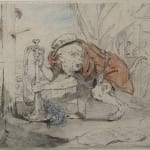Sir Edwin Henry Landseer RA English, 1802-1873
Monkey at a Fair
Pencil & Colour Washes
Size without frame: 7 x 9 inches
With frame 10 x 12inches
With frame 10 x 12inches
£ 2,500.00
Landseer was fascinated from a young age by the travelling fairs around London and the animals, in particular monkeys, had a profound effect on his art. The metaphor of monkeys in art came across from Northern Europe and Landseer was to elaborate on this theme many times. This sketch was sold at Landseer’s posthumous artist’s studio sale in 1874.
Painter in oil of animals, portraits, landscapes and narrative subjects. Although not Scottish, this great Victorian animal painter influenced the appreciation and development of Scottish art in two ways. First, his association with many of the leading figures in British life, from Queen Victoria downwards, a large number of whom were Scottish, and second, the paintings and drawings themselves which were a major factor in placing Scotland on the artistic and social map of the western world. Visited Scotland for the first time in 1824 meeting Sir Walter Scott and as a guest of the Duke of Atholl at Blair Atholl, falling in love with the Highlands. Made studies of the Duke’s keepers and of red deer which eventually became part of Death of a Stag in Glen Tilt.
Spent ten days at Abbotsford, home of Sir Walter Scott, and in 1826 Scott described Landseer’s dogs as ‘the most magnificent things I ever saw – leaping, and bounding, and grinning on the canvas’. The artist was chosen to illustrate the Waverley edition of Scott’s novels and visited Scotland every year for the rest of his life.
Queen Victoria appointed him Animal Painter to Her Majesty in Scotland. His whole career was inextricably intertwined with the Scottish scene. Landseer paid brief visits to Balmoral during three consecutive autumns and in 1854 Queen Victoria sat for him for the last time. His last important Royal commission was a pair of contrasting subjects ‘Sunshine’, a recollection of Prince Albert in the Highlands, and ‘Sorrow’, depicting Queen Victoria as a widow at Osborne.
Painter in oil of animals, portraits, landscapes and narrative subjects. Although not Scottish, this great Victorian animal painter influenced the appreciation and development of Scottish art in two ways. First, his association with many of the leading figures in British life, from Queen Victoria downwards, a large number of whom were Scottish, and second, the paintings and drawings themselves which were a major factor in placing Scotland on the artistic and social map of the western world. Visited Scotland for the first time in 1824 meeting Sir Walter Scott and as a guest of the Duke of Atholl at Blair Atholl, falling in love with the Highlands. Made studies of the Duke’s keepers and of red deer which eventually became part of Death of a Stag in Glen Tilt.
Spent ten days at Abbotsford, home of Sir Walter Scott, and in 1826 Scott described Landseer’s dogs as ‘the most magnificent things I ever saw – leaping, and bounding, and grinning on the canvas’. The artist was chosen to illustrate the Waverley edition of Scott’s novels and visited Scotland every year for the rest of his life.
Queen Victoria appointed him Animal Painter to Her Majesty in Scotland. His whole career was inextricably intertwined with the Scottish scene. Landseer paid brief visits to Balmoral during three consecutive autumns and in 1854 Queen Victoria sat for him for the last time. His last important Royal commission was a pair of contrasting subjects ‘Sunshine’, a recollection of Prince Albert in the Highlands, and ‘Sorrow’, depicting Queen Victoria as a widow at Osborne.
Join our mailing list
McEwan Gallery Newsletter
* denotes required fields
We will process the personal data you have supplied in accordance with our privacy policy (available on request). You can unsubscribe or change your preferences at any time by clicking the link in our emails.



